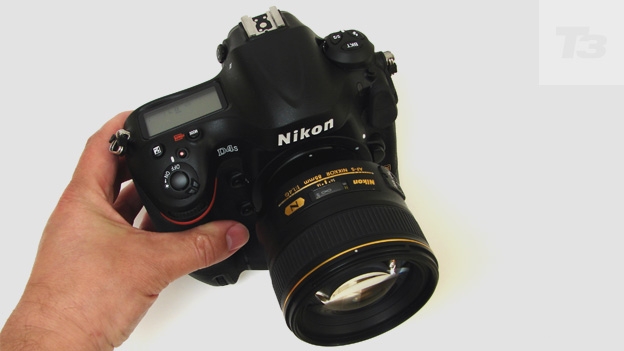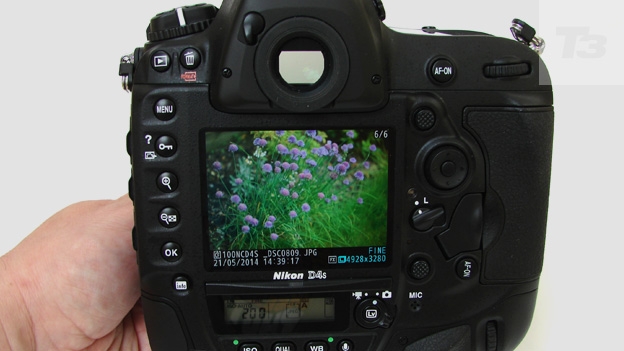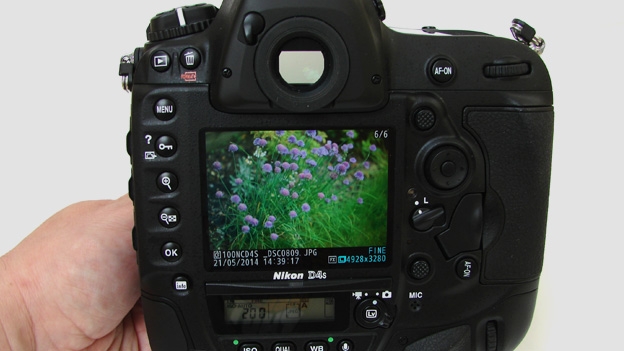Nikon D4S review
Flagship Nikon D4S DSLR may just be the best to date


-
+
Lightning fast response
-
+
Full frame image sensor
-
+
Huge bright viewfinder
-
-
Massively expensive
-
-
Non-tilting (fixed) LCD
-
-
No body integral anti shake
Why you can trust T3







Won the lottery and want possibly the best DSLR in the business? Find out if Nikon's new full frame shooting D4S fits the bill
While most system cameras pride themselves on being smaller and lighter than the previous model, the new full 35mm frame shooting Nikon D4S DSLR follows on from the Nikon D4 in being big, bold and proud of it.
Part of the bulk is due to a vertical handgrip and battery compartment that will house two cells at once - a screw-on 'extra' for most DSLRs, but here built in from the off.
Such features are justified by the fact that this is Nikon's flagship professional model, built to withstand bumps, knocks and scrapes, and expected to provide enough power - in terms of both processing and energy - to keep shooting when most DSLRs would have given up the ghost.
We even get a twin battery charger in the box to charge the main battery and any bought spare simultaneously. When you're on a professional assignment, obviously speed is everything.
Given the above, a wince inducing body-only price of £5,000+ isn't a total surprise. And, if we were spending that amount, then we actually would want something that feels like we're hefting a car battery when we pick it up, as this does.
Hell, for this money we could buy an actual car, especially when lenses are factored in, like the super bright 85mm f/1.4 prime portrait lens Nikon provided us with for testing. On its own this costs over a grand. No wonder its manufacturer is claiming this is the ultimate imaging machine.
So what's new on the D4S? Well, an expanded low-light sensitivity range up to an incredible ISO409,600 equivalent and a 30% faster processing engine, aiding those whom not only need to work quickly, but also shoot in challenging conditions.
Auto focus performance when shooting at up to class-leading 11 frames per second has also been improved (up from 10fps), the upshot also being better end results in terms of images.
Speed, quality these will be music to the ears of the DSLR's intended audience of sports, press and nature photographers.
Commercial photographers are still probably better off with the cheaper Nikon D800/e DSLR, which offers a huge 36-megapixel resolution rather than the speediest capture. By contrast the D4S makes do with a 'mere' 16 megapixels.
The Nikon D4S' closest rivals are still the ageing likes of the Canon EOS-1D X, costing anywhere between £4K and £5K dependant on where you shop, and the Sony A99 at £1,999.
Both are full frame models, but have been around for a couple of years or more. Still, given its premium asking price, Nikon's re-tooled flagship needs to justify its existence with a performance to put all others in the shade. So how does it handle?
Nikon D4S: Controls
The D4S's layout is probably pretty much exactly what most of us envisage in our mind's eye when we think of a 'professional' DSLR.
There are buttons, dials, levers and locks aplenty, and not one, not two, but three LCD windows, all displaying numbers and symbols like something from a flight simulator.
And that's before we've even peeked into the huge eye-level viewfinder, which is impressive and comfortable to use, even if our nose does squish against the left side of the largest LCD immediately below.
The size of the camera and its grip is such that we managed to get the full four fingers around it - with room for a couple of more digits, if you possess them.
When combined with the weight of a lens, this is very much a camera for two-handed operation, and the layout is designed for that.
Thus we get menu and function buttons running down the left hand side of the screen for implementation via the left thumb, while the thumb of the right hand controls the various command wheels and joysticks to the right, which are used for tabbing through function screens or scrolling through batches of images.
Metering, flash and exposure bracketing all get their own buttons atop a control dial located to the left of the top plate, while below that we get drive/capture modes, such as single shot or continuous shooting.
As this is a pro model, there's no integral pop-up flash, but rather a familiar vacant hotshoe via which to attach one. You pay this kind of money and you're going to want the best results - so off-camera flash, which will enable us to angle and bounce its beam for more flattering portraiture, is preferable.
It's worth noting how fast the D4S' controls are to respond. Flick the on/off lever that surrounds the shutter release button for example, and the camera is up and running without any noticeable pause.
This is a DSLR that, once you see the moment, will allow you to capture it before it's gone - perfect for photojournalists. Squeeze the shutter release and there's an audible crunch as the shutter satisfyingly fires.
Nikon D4S: Screen
No fancy articulated screen here - the main LCD is resolutely fixed. Can't imagine the market audience for the D4S is going to be worrying about shooting selfies anyway. Not when there's a large and bright eye-level viewfinder slapped right above said screen, enabling a traditional means of shot composition.
The LCD is a larger than average 3.2 inches in size, the same as the previous D4, even if the actual resolution at 920,000 dots is hardly pushing the boat out, in these days of 1.4 million dot screens and counting elsewhere. Still, images look great on the screen and there's sufficient detail to tell whether any given shot is in focus or not without having to enlarge portions.
Unlike on say a compact system camera or a regular pocket snapper, unless you've pressed the menu button to drill into the camera's functionality, are displaying an already captured image, or have switched to Live View mode, then the screen remains blank, so as not to distract from use of the optical viewfinder above. The screen is an essential part here, but not the most preferable means which images are framed.
Nikon D4S: Battery
The brick-like rechargeable lithium-ion battery supplied with the D4S slots into the extra room at the base of the camera.
It's worth noting that the high-powered charger supplied is very quick to replenish tired batteries, with indicators telling us when we're 50%, 80% or 100% charged, so if necessary we could grab and use the battery before it had completed its recharging cycle.
The official CIPA tested figure for power duration is an incredible 3,000+ shots per charge. That's over three times the performance of most semi-pro DSLRs, and as we've noted there's room for a second battery too. This is a heavyweight performer by any definition.
Nikon D4S: Picture quality
Spend this sort of money and we're expecting something at the very pinnacle of what a digital camera based on a 35mm film SLR body can achieve.
Unsurprisingly, the pictures from the D4S, when equipped with the 85mm prime lens we had to play with, were an absolute knockout.
Portraits were impressively life-like with plenty of contrast and depth straight out of the camera, while still life shots really brought out the colours and had an almost creamy consistency to them in terms of the 'bokeh' (shallow depth of field) proved by using the bright f/1.4 aperture, which threw everything surrounding our core subjects out of focus.
The largest sensor to be found in a 35mm camera-based DSLR - i.e a full frame sensor based on the dimensions of a 35mm film frame of old - coupled with a respectable, rather than excessive amount of pixels ensured that noise was resolutely free from images the higher we climbed up the available ISO settings.
This might not be the first tool one might consider when it comes to shooting video, but the inclusion of Full HD capability as well as stills makes this model a news-gathering all rounder - even if we do have to switch to Live View mode and have the whole performance of the mirror flipping out of the way before we can start shooting.
But a fast processor has at least ensured the ability to shoot at 60fps for a very cinematic feel, which is no mean feat.
Nikon D4S: Verdict
Strap the D4S on and you almost feel like you've put on a suit of armour. Immediately we're walking taller. Admittedly not all of us are going to want or afford to splash this sort of balance-battering cash; the 16 megapixel, 11 frames per second D4S is very much a specialists' tool.
But if you demand the very best on the market when it comes to portable digital cameras - as opposed to something like a medium format camera largely used in the studio - then the reassuringly bulky and weighty Nikon D4S has got to take top billing for those who place speed of capture as important as detail.
See an image in your mind's eye and instantly capture it. That's got to be worth paying for. As is the fact that if you buy this you will very probably not need to buy another digital camera ever again.
Nikon D4S release date: Out now
Nikon D4S price: £5199 (body only)
Get all the latest news, reviews, deals and buying guides on gorgeous tech, home and active products from the T3 experts

Gavin Stoker has been writing about photography and technology for the past 20 years. He currently edits the trade magazine British Photographic Industry News - BPI News for short - which is a member of TIPA, the international Technical Imaging Press Association.